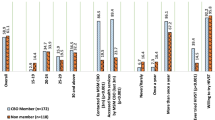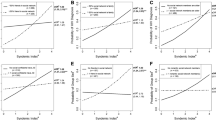Abstract
Despite the potential for sexual health communication to be leveraged for HIV prevention among youth experiencing homelessness (YEH), there has yet to be a rigorous examination of individual and network or relational characteristics associated with sexual health communication in this group of young people. Cross-sectional survey and social network data from 1014 YEH aged 14–25 recruited in Los Angeles, California, were utilized to assess individual and network or relational characteristics associated with communication regarding condom use and HIV testing among YEH. Results suggest that social networks are key to understanding sexual health communication; YEH’s engagement in sexual health communication was significantly related to the composition of their networks. To increase testing and decrease new HIV cases, a prudent strategy would be to train existing social network members (e.g., staff members, home-based peers, or partners) as agents of change in naturally occurring social networks of YEH.
Similar content being viewed by others
References
Bandura A. On integrating social cognitive and social diffusion theories. Commun Innov. 2006. https://doi.org/10.4135/9788132113775.n5.
Barman-Adhikari A, Bowen E, Bender K, Brown S, Rice E. A social capital approach to identifying correlates of perceived social support among homeless youth. Child Youth Care Forum. 2016;45(5):691–708. https://doi.org/10.1007/s10566-016-9352-3.
Barman-Adhikari A, Craddock J, Bowen E, Das R, Rice E. The relative influence of injunctive and descriptive social norms on methamphetamine, heroin, and injection drug use among homeless youths: the impact of different referent groups. J Drug Issues. 2018;48(1):17–35. https://doi.org/10.1177/0022042617726080.
Barman-Adhikari A, Hsu HT, Begun S, Portillo AP, Rice E. Condomless sex among homeless youth: the role of multidimensional social norms and gender. AIDS Behav. 2017;21(3):688–702. https://doi.org/10.1007/s10461-016-1624-2.
Barth KR, Cook RL, Downs JS, Switzer GE, Fischhoff B. Social stigma and negative consequences: factors that influence college students’ decisions to seek testing for sexually transmitted infections. J Am Coll Health. 2002;50:153–9. https://doi.org/10.1080/07448480209596021.
Becker S. Couples and reproductive health: a review of couple studies. Stud Family Plan. 1996;27(6):291–306.
Begun S. The paradox of homeless youth pregnancy: a review of challenges and opportunities. Soc Work Health Care. 2015;54:444–60. https://doi.org/10.1080/00981389.2015.1030058.
Branson BM, Handsfield HH, Lampe MA, Janssen RS, Taylor AW, Lyss SB, Clark JE. Revised recommendations for HIV testing of adults, adolescents, and pregnant women in health-care settings. Morb Mortal Wkly Rep. 2006;55(14):1–17.
Centers for Disease Control and Prevention. HIV surveillance report, 2016 ed., vol. 28. Retrieved from http://www.cdc.gov/hiv/library/reports/hiv-surveillance.html. 2017.
Centers for Disease Control and Prevention. Effective interventions: HIV prevention that works. Retrieved from https://effectiveinterventions.cdc.gov/docs/default-source/general-docs/16-0817-hip-overview-factsheet.pdf?sfvrsn=4. 2016.
Centers for Disease Control and Prevention. HIV in the United States and dependent areas. Retrieved from: https://www.cdc.gov/hiv/pdf/statistics/overview/cdc-hiv-us-ataglance.pdf. 2019.
Conrad C, Bradley HM, Broz D, Buddha S, Chapman EL, Galang RR, et al. Community outbreak of HIV infection linked to injection drug use of oxymorphone—Indiana, 2015. MMWR Morb Mortal Wkly Rep. 2015;64(16):443.
Craddock JB, Rice E, Rhoades H, Winetrobe H. Are parental relationships always protective? A social network analysis of Black, Latino, and White homeless youth and sexual risk-taking behaviors. Prev Sci. 2016. https://doi.org/10.1007/s11121-016-0684-x.
Dearing JW, Rogers EM, Meyer G, Casey MK, Rao N, Campo S, Henderson GM. Social marketing and diffusion-based strategies for communicating with unique populations: HIV prevention in San Francisco. J Health Commun. 1996;1(4):343–63.
Drumhiller K, Murray A, Gaul Z, Aholou TM, Sutton MY, Nanin J. “We Deserve Better!”: perceptions of HIV testing campaigns Among Black and Latino MSM in New York City. Arch Sex Behav. 2018;47(1):289–97.
Fothergill K, Feijoo A. Family planning services at school-based health centers: findings from a national survey. J Adolesc Health. 2000;27:166–9. https://doi.org/10.1016/S1054-139X(00)00122-1.
Freimuth VS, Hammond SL, Edgar T, McDonald DA, Fink EL. Factors explaining intent, discussion and use of condoms in first-time sexual encounters. Health Educ Res. 1992;7(2):203–15. https://doi.org/10.1093/her/7.2.203.
Fulginiti A, Pahwa R, Frey LM, Rice E, Brekke JS. What factors influence the decision to share suicidal thoughts? A multilevel social network analysis of disclosure among individuals with serious mental illness. Suicide Life-Threat Behav. 2016;46(4):398–412.
Fulginiti A, Rice E, Hsu HT, Rhoades H, Winetrobe H. Risky integration: a social network analysis of network position, exposure, and suicidal ideation among homeless youth. Crisis. 2016;37(3):184. https://doi.org/10.1027/0227-5910/a000374.
Ghanem KG, Hutton HE, Zenilman JM, Zimba R, Erbelding EJ. Audio computer assisted self-interview and face to face interview modes in assessing response bias among STD clinic patients. Sex Transm Infect. 2005;81(5):421–5.
Gillespie BJ, Frederick D, Harari L, Grov C. Homophily, close friendship, and life satisfaction among gay, lesbian, heterosexual, and bisexual men and women. PLoS ONE. 2015;10(6):e0128900.
Golden MR, Lechtenberg R, Glick SN, Dombrowski J, Duchin J, Reuer JR, et al. Outbreak of human immunodeficiency virus infection among heterosexual persons who are living homeless and inject drugs—Seattle, Washington, 2018. Morb Mortal Wkly Rep. 2019;68(15):344.
Gómez CA, Marin BV. Gender, culture, and power: barriers to HIV-prevention strategies for women. J Sex Res. 1996;33(4):355–62.
Granovetter M. The strength of weak ties: a network theory revisited. Sociol Theory. 1983. https://doi.org/10.2307/202051.
Halcón LL, Lifson AR. Prevalence and predictors of sexual risks among homeless youth. J Youth Adolesc. 2004;33:71–80. https://doi.org/10.1023/A:1027338514930.
Hall KS, Moreau C, Trussell J. Determinants of and disparities in reproductive health service use among adolescent and young adult women in the United States, 2002–2008. Am J Public Health. 2012;102(2):359–67. https://doi.org/10.2105/AJPH.2011.300380.
Hammer H, Finkelhor D, Sedlak AJ. Runaway/thrownaway children: National estimates and characteristics (NCJ Publication No. 196469). Retrieved from https://www.ncjrs.gov/pdffiles1/ojjdp/196469.pdf. 2002.
Hawkins RP, Kreuter M, Resnicow K, Fishbein M, Dijkstra A. Understanding tailoring in communicating about health. Health Educ Res. 2008;23(3):454–66.
Jha Y, Welch E. The relationship between multiplexity and academic productivity in six fields of science and engineering. Georgia Institute of Technology. 2009.
Kennedy DP, Tucker JS, Green HD Jr, Golinelli D, Ewing B. Unprotected sex of homeless youth: results from a multilevel analysis of individual, social network, and relationship factors. AIDS Behav. 2012;16:2015–32. https://doi.org/10.1007/s10461-012-0195-0.
Kennedy MC, Jansson M, Benoit C, Magnuson D, Scramstad J, Hallgrimsdottir H. Social relationships and social support among street-involved youth. J Youth Stud. 2017;20:1328–45. https://doi.org/10.1080/13676261.2017.1333582.
Logan JD. Applied mathematics. Hoboken: Wiley; 2013.
Mathur S, Mullinax M, Santelli JS. Prevention of sexually transmitted infections among adolescents. International handbook on adolescent health and development. Cham: Springer; 2017. p. 183–205.
McPherson M, Smith-Lovin L, Cook JM. Birds of a feather: homophily in social networks. Ann Rev Sociol. 2001;27(1):415–44.
Milburn NG, Batterham P, Ayala G, Rice E, Solorio R, Desmond K, et al. Discrimination and mental health problems among homeless minority young people. Public Health Rep. 2010;125(1):61–7.
Molino AC. Characteristics of help-seeking street youth and non-street youth. In: Paper presented at the 2007 National Symposium on Homelessness Research, Chicago, IL. Retrieved from https://aspe.hhs.gov/system/files/pdf/180451/report.pdf. (2007).
Morris JL, Lippman SA, Philip S, Bernstein K, Neilands TB, Lightfoot M. Sexually transmitted infection related stigma and shame among African American male youth: implications for testing practices, partner notification, and treatment. AIDS Patient Care STDs. 2014;28:499–506. https://doi.org/10.1089/apc.2013.0316.
Morrison-Beedy D, Carey MP, Tu X. Accuracy of audio computer-assisted self-interviewing (ACASI) and self-administered questionnaires for the assessment of sexual behavior. AIDS Behav. 2006;10(5):541–52.
Napper LE, Fisher DG, Reynolds GL, Johnson ME. HIV risk behavior self-report reliability at different recall periods. AIDS Behav. 2010;14(1):152–61.
Prestage G, Mao L, McGuigan D, Crawford J, Kippax S, Kaldor J, Grulich AE. HIV risk and communication between regular partners in a cohort of HIV-negative gay men. AIDS Care. 2006;18(2):166–72.
Rew L. Sexual health practices of homeless youth: a model for intervention. Issues Compr Pediatric Nurs. 2001;24:1–18. https://doi.org/10.1080/119-01460860151062424.
Rice E, Barman-Adhikari A, Milburn NG, Monro W. Position-specific HIV risk in a large network of homeless youths. Am J Public Health. 2012;102(1):141–7. https://doi.org/10.2105/AJPH.2011.300295.
Rice E, Comulada S, Green S, Arnold EM, Rotheram-Borus MJ. Differential disclosure across social network ties among women living with HIV. AIDS Behav. 2009;13:1253–61. https://doi.org/10.1007/s10461-009-9554-x.
Rice E, Kurzban S, Ray D. Homeless but connected: the role of heterogeneous social network ties and social networking technology in the mental health outcomes of street-living adolescents. Community Ment Health J. 2012;48(6):692–8. https://doi.org/10.1007/s10597-011-9462-1.
Rice E, Lee A, Taitt S. Cell phone use among homeless youth: potential for new health interventions and research. J Urban Health. 2011;88:1175–82. https://doi.org/10.1007/s11524-011-9624-z.
Santa Maria D, Hernandez D, Arlinghaus K, Gallardo K, Maness S, Kendzor D, et al. Current age, age at first sex, age at first homelessness, and HIV risk perceptions predict sexual risk behaviors among sexually active homeless adults. Int J Environ Res Public Health. 2018;15(2):218.
Saul J, Norris FH, Bartholow KK, Dixon D, Peters M, Moore J. Heterosexual risk for HIV among Puerto Rican women: does power influence self-protective behavior? AIDS Behav. 2000;4(4):361–71. https://doi.org/10.1023/A:1026402522828.
Smith H. Searching for kinship: the creation of street families among homeless youth. Am Behav Sci. 2008;51:756–71. https://doi.org/10.1177/0002764207311986.
Solorio MR, Rosenthal D, Milburn NG, Weiss RE, Batterham PJ, Gandara M, Rotheram-Borus MJ. Predictors of sexual risk behaviors among newly homeless youth: a longitudinal study. J Adolesc Health. 2008;42:401–9. https://doi.org/10.1016/j.jadohealth.2007.09.023.
Tevendale HD, Lightfoot M, Slocum SL. Individual and environmental protective factors for risky sexual behavior among homeless youth: an exploration of gender differences. AIDS Behav. 2009;13:154–64. https://doi.org/10.1007/s10461-008-9395-z.
Tyler KA. Homeless youths’ HIV risk behaviors with strangers: investigating the importance of social networks. Arch Sex Behav. 2013;42(8):1583–91. https://doi.org/10.1007/s10508-013-0091-3.
Valente TW, Fosados R. Diffusion of innovations and network segmentation: the part played by people in promoting health. Sex Transm Dis. 2006;33(7 Suppl):S23–31. https://doi.org/10.1097/01.olq.0000221018.32533.6d.
Van der Straten A, Catania JA, Pollack L. Psychosocial correlates of health-protective sexual communication with new sexual partners: the National AIDS Behavioral Survey. AIDS Behav. 1998;2(3):213–27. https://doi.org/10.1023/A:1022137817863.
Wasserman S, Faust K. Social network analysis: methods and applications. Cambridge: Cambridge University Press; 1994.
Wenzel S, Holloway I, Golinelli D, Ewing B, Bowman R, Tucker J. Social networks of homeless youth in emerging adulthood. J Youth Adolesc. 2012;41(5):561–71. https://doi.org/10.1007/s10964-011-9709-8.
Widman L, Choukas-Bradley S, Helms SW, Golin CE, Prinstein MJ. Sexual communication between early adolescents and their dating partners, parents, and best friends. J Sex Res. 2014;51:731–41. https://doi.org/10.1080/00224499.2013.843148.
Widman L, Noar SM, Choukas-Bradley S, Francis DB. Adolescent sexual health communication and condom-use: a meta-analysis. Health Psychol. 2014;33:1113–24. https://doi.org/10.1037/hea0000112.
Wight D. Impediments to safer heterosexual sex: a review of research with young people. AIDS Care. 1992;4(1):11–23. https://doi.org/10.1080/09540129208251616.
Funding
This study was funded by NIMH (R01 MH093396).
Author information
Authors and Affiliations
Corresponding author
Ethics declarations
Conflicts of interest
All the authors of this study have no conflict of interest to report.
Additional information
Publisher's Note
Springer Nature remains neutral with regard to jurisdictional claims in published maps and institutional affiliations.
Rights and permissions
About this article
Cite this article
Craddock, J.B., Barman-Adhikari, A., Combs, K.M. et al. Individual and Social Network Correlates of Sexual Health Communication Among Youth Experiencing Homelessness. AIDS Behav 24, 222–232 (2020). https://doi.org/10.1007/s10461-019-02646-x
Published:
Issue Date:
DOI: https://doi.org/10.1007/s10461-019-02646-x




